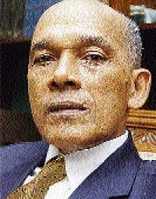
Derick Latibeaudiere, Bank of Jamaica governor, has been advised by the IMF to raise interest rates. - File
The Bank of Jamaica (BOJ) incorporates the following within the framework of its monetary policy operations: Whereas an expansion of money supply facilitates economic growth, excessive increases in the rate of growth of money supply have an adverse effect on the price level and the level of income in an economy.
The modern (monetarist) theoretical foundation of the above observation is derived from Milton Friedman's 'Quantity Theory of Money'. This theory states that in the long run, increased monetary growth increases prices but has little or no effect on output. However, in the short run, increases in money-supply growth cause employment and output to increase, and decreases in money supply growth have the opposite effect.
Out of the above theory, Friedman developed a money-supply rule to solve the problems of inflation and short-run fluctuations in employment and real GDP. The money supply rule states that if a central bank should increase the money-supply at the same rate as real GDP increased, inflation would disappear.
Although the BOJ acknowledges the primacy of the link between money supply and economic growth (similar to the Friedman's rule), the bank's descriptive schematic flow of the transmission of monetary policy has no measuring mechanism to highlight 'excessive increases in the growth of money supply' to recognise and report on 'monetary inflation', or, a schematic to show a consequential relationship between the movement of money supply and economic growth. Instead, the bank's focus is entirely on the consumer price index (CPI) - a measure calculated external to the bank. The bank should calculate monetary inflation and translate or compare the results with the CPI.
The absence of any published data on the foregoing raises some fundamental questions for the BOJ. Over the period January 1, 1996-December 31, 2007, the stock of money (M2) increased by 407 per cent, from $73.6B to $300.0B, an average annual rate of 12 per cent. Were these annual increases (expansion of money supply) targeted at a specific GDP outturn (facilitation of economic growth)? Were the annual targets met? If not, did the BOJ fail? Further, is the BOJ statement "Expansion of money supply facilitates economic growth" true and relevant to the central bank and the Jamaican economy?
Money Supply & Open-Market Operations
As noted above, between 1996-2007, standard money supply (M2) increased by $226B and this "excess" has remained in the economy. Another form of money supply, called excess liquidity, is pulled from the system and retained by the BOJ. Because of its closeness to M2, it may also be called M2A, or more appropriately, domestic hot money for short. Between 1996-2007 the BOJ increased excess liquidity on its balance sheet by $112B, from $2B to $114B.
Concurrent with the growth in excess liquidity on the bank's balance sheets (1996-2007) was the phenomenal growth in foreign assets. The $112B growth in excess liquidity was evenly matched by $108B growth in foreign assets. This category increased from $26B to $134B. As the table below shows, other assets of the bank grew by $50B while foreign assets grew by $108B (twice as much). Other liabilities grew by $40B with open-market instruments growing by $112B (nearly three times as much).
The above balance-sheet changes have produced the classic asset/liability mismatch syndrome. The bank has found itself servicing obligations in a high-interest rate environment domestically, created by its own policies, while investing the matching obligations in a low-interest-rate environment, internationally. This situation has started to negatively impact the financial operations of the bank. Since 2001, the bank has been recording an annual negative net-interest margin (NIM). That is, the bank has paid out more in interest than it has earned. For the past seven years, 2001-2007, the bank has recorded negative NIMs for each year of its operations, for a total of $21B.
Monetary Policy Tools (Open-Market Operations - OMO)
In 2000, the BOJ described its OMO, established in 1994, as an indirect monetary policy tool which is utilised by selling from its stock of risk-free (Government) securities or, the use of these securities as collateral for short-term loans called reverse repurchase agreements. These agreements ranged in tenor/maturity from 30-180 days. In that same year, the BOJ was most emphatic in stating that:
"The BOJ uses reverse repurchase transactions as the dominant facet to conduct open-market operations. At the same time, the BOJ also stated that open-market operations can also be conducted without the use of Government securities by certificates of deposit."
By comparison, the Federal Reserve, in pursuit of its monetary objectives, makes no reference to CDs and describes its use of repurchase and reverse repurchase transactions as follows:
Under a repurchase agree-ment, the Fed buys government securities from a dealer who agrees to buy them back, typically within one to seven days; a reverse repurchase is the opposite.
The Fed uses these two types of transactions to offset temporary swings in bank reserves.
Repurchases initially add reserves to the banking system and then withdraw them; reverse repurchases initially drain reserves and later add them back.
It is significant to note that the Fed's reverse repurchases initially drain reserves but later add them back. As we shall see later, in contrast, the BOJ drains but never adds back.
The BOJ's history with CDs dates back to the 1980s during Jamaica's fully regulated financial regime. However, after the full implementation of its new OMO system in 1994, CDs were finally removed from the bank's bi-weekly balance sheet on March 8, 1995.
Year over year CD balances on the balance sheets for December 1993-December 1994, prior to their removal, were $3.1B and $2.6B, respectively. These were matched with holdings of marketable securities of $5.0 billion and $6.2B for the comparable dates in 1993 and 1994.
In 2000, when the earlier quoted statement on CDs was made by the BOJ, there was no verifiable evidence of CD issues by the bank. However, at that time, as well as in 1994 at the inception of the new system, CDs were contemplated as a complementary OMO tool involving a small percentage of the bank's total open-market liabilities and of small denominations, short durations and secured by the bank's stock of marketable securities.
Central Bank statements
However, the following statements from the central bank would suggest otherwise:
1. The central bank issues its own instrument (a deposit) which is backed by the central bank's guarantee of the amount deposited
2. Except for the underlying securities, all other terms and conditions applicable to the reverse repurchase transactions apply to CDs.
The central bank, from the above statements, offering its own guarantee and no underlying securities for CDs, by these declared measures, if fully implemented, would radically transform the bank's open-market activities, a central bank's exclusive prerogative, into a normal commercial bank's deposit-taking activity.
Indeed, the activities of the bank, as regards CDs, especially since March of 2000, have fully vindicated the concerns outlined above and these activities are now responsible for the financial quagmire in which the bank finds itself.
The first observation in this regard is the failure of the bank to use its reverse repurchases mechanism to modulate the flow of liquidity within the system. As the Federal Reserve explains: drain and replenish. For 13 years, 1996-20008, the BOJ has only drained.
At the start of 1996, the external auditors reported that the BOJ had a stock of $17B in marketable (GOJ) securities. Of this amount, $2.1B (12 %) was used as collateral for the bank's OMO instruments (securities sold under repurchase agreements). By 1999, the auditors reported $ 32.3B in marketable securities with $27.4 (85%) used as collateral in OMO. For the five bi-weekly balance sheets published in the first quarter of 2000 (January 12-March 8) the collateralisation ratio/percentage remained at 85 per cent. However, the next bi-weekly balance sheet, March 22, 2000, started an uninterrupted run of 53 bi-weekly balance sheets showing that the "instruments" being issued by the BOJ were not fully collateralised. When the explanation was provided on the balance sheet of June 12, 2002, it was revealed that a balance reported as "Other Demand Liabilities" was in fact CDs. At that point, the collateralisation coverage was only 26 per cent. That meant $26B in security for $ 100B in "open-market" obligations.
explanation
The explanation from the BOJ on June 12, 2002, for the disguised CDs was:
"At 12th June 2002, the liabilities for Open Market Instruments include Reverse Repurchase Agreements of $25.18B and certificates of deposit of $70.00B previously shown under Other Demand Liabilities."
The deliberate and consistent manner in which the bank concealed its CD-issuing activities from the public for over two years, necessitated a close examination of the auditors' treatment of CDs and reverse repos for the two financial years affected by the disguise - 2000 and 2001.
FY2000. In Note 14 of 2000, the auditors introduced a subtle change. Whereas in 1999, and earlier, they referred to a straightforward delivery and receipt of securities, in 2000, they changed to: "Delivery of certificates evidencing transfer of interest in securities." Further, the audited balance sheet for that year showed a 50 per cent excess of reverse repurchases over the bank's marketable securities, $42B to $28B, respectively. In addition, the published balance sheet showed $6.1B in demand liabilities. Taken together, these strongly suggest the presence of CDs, but there was no confirmation from the auditors.
FY2001. The revised statement on delivery continued. Reverse repurchases balance was again in excess of marketable securities by 32 per cent. And, CDs of $43B were aggregated on the balance sheet under demand liabilities and appropriately disclosed in Note 13. The auditors' certificate for 2001 was signed on April 8, 2002, and the bank transmitted the auditors' report to the minister on April 12, 2002. The bank admitted the issuance of CDs in the accompanying notes to its balance sheet on May 22, 2002, but did not enter a line item on the balance sheet itself entitled: Certificates of Deposit. Instead, since June 12, 2002, the bank has continuously labelled its CDs open-market instruments.
Two interesting questions arise from the observed behaviour between the bank and the auditors. First, did the bank advise the auditors about the CDs in 2000, or, conversely, should the auditors have known independently? Second, was the bank forced to reveal its CD-accumulating activities only after the auditors released their report showing the presence of CDs?
See Part 3 in Wednesday Business.

Keith Senior - Keith senior is a highly respected financial analyst who has worked internationally and has advised the Jamaican Government in various areas of its operation. For a time, he served on the board of the island's central bank, the Bank of Jamaica (BOJ).
Now, Senior has cast a critical eye on the performance of the BOJ over the past dozen years, a period that coincides with the tenure of its current governor, Derick Latibeaudiere, and has found it wanting.
In this, the second of a four-part series, Senior analyses what he sees as almost a three-card trick by the BOJ in its open-market operations.